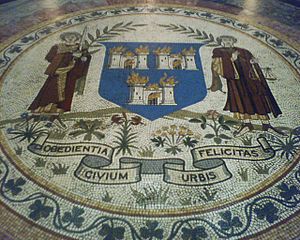City Hall, Dublin facts for kids
Quick facts for kids City Hall, Dublin |
|
|---|---|
|
Halla na Cathrach, Baile Átha Cliath
|
|

Dublin City Hall from Cork Hill
|
|
| Former names | The Royal Exchange |
| General information | |
| Address | Dame Street, Dublin 2 |
| Town or city | Dublin |
| Country | Ireland |
| Coordinates | 53°20′38″N 6°16′02″W / 53.343854°N 6.267154°W |
| Elevation | 8 metres (26 ft) |
| Construction started | 1769 |
| Completed | 1779 |
| Design and construction | |
| Architect | Thomas Cooley |
The City Hall, Dublin (Halla na Cathrach, Baile Átha Cliath in Irish) is an important building in Dublin, Ireland. It was built a long time ago, between 1769 and 1779. A famous architect named Thomas Cooley designed it. This building is a great example of 18th-century architecture in the city.
At first, it was a place for Dublin's business people. Today, it is where the Dublin City Council meets. They make important decisions for the city here.
Contents
Where is Dublin City Hall?

Dublin City Hall is on Dame Street, a busy road in the city. It sits on a small hill at the end of Parliament Street. The building is also very close to Dublin Castle. This castle was once the main place for the British government in Ireland until 1922.
The Story of City Hall
The land where City Hall stands has a rich history. Before the City Hall, there was a house called Cork House. It belonged to the Earl of Cork. There was also a coffee shop and even an old church on this spot.
Parliament Street was created in 1753. This new street connected to Capel Street across the Liffey. The City Hall was first known as the Royal Exchange. Thomas Cooley won a competition to design it. The first stone was laid on August 2, 1769. The building officially opened in 1779.
What was the Royal Exchange for?
The Royal Exchange was like an early stock exchange. It was a place where Dublin's business people could meet. They would discuss deals and trade goods. It was also near the old Custom House. This made it easy for merchants from other countries to visit.
The Irish Parliament paid for the building. This is why you can see the letters "SPQH" on it. These letters mean "The senate and people of Ireland." It's like a special message from the past!
From Exchange to City Hall
For a long time, Dublin's city government met in different places. In the 1850s, the city government, called Dublin Corporation back then, bought the Royal Exchange. They changed it to be their new meeting place.
They added new stairs and divided up some rooms. On September 30, 1852, the Royal Exchange was officially renamed City Hall. This was at the first meeting of the Dublin City Council held there. Later, beautiful paintings called frescos were added. These paintings show different parts of Ireland.
City Hall During the 1916 Rising
During the 1916 Easter Rising, City Hall played a small but important role. A group called the Irish Citizen Army used it as a base. About 35 people were there, mostly women.
A man named Sean Connolly took control of the building. He worked in the motor department and had a key. The fighting around City Hall lasted for about 12 hours.
How City Hall is Built
The outside of City Hall is mostly made of white Portland stone. This stone comes from a quarry in England. The building has a grand entrance hall called a Rotunda. It has a huge dome supported by twelve tall columns.
These columns are about 32 feet (9.7 meters) high. The dome itself is another 10 feet (3 meters) above them. Around the columns is a walkway. This is where merchants used to walk and talk about their business.
What City Hall is Used For Today
Some important council meetings still happen in City Hall. The city government is now called Dublin City Council. Most of the council staff work in a newer building nearby. This building is called the Civic Offices.
You can also visit an exhibition inside City Hall. It's called "Dublin City Hall, The Story of the Capital." It tells you all about the history of Dublin City.
Images for kids







